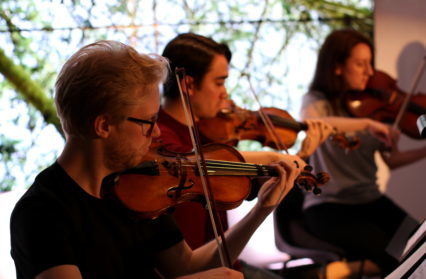Cath Barton was at the Tramshed Tech space in Cardiff to see Sinfonia Cymru’s curation of #JoyRide.
More than being just a chamber orchestra, Sinfonia Cymru operates as a loose collective of young professional creatives who, in the Curate programme (running since 2013) are given their heads to develop their own projects. #JoyRide is the last in the 2017/18 Curate season and, like the previous three concerts, was streamed live on Facebook and remains available there for 30 days after the event.
With its digital ‘kit’, comfortable armchair seating and bar, Tramshed Tech has proved itself an ideal venue for a contemporary version of the nineteenth century European salon, a place for sharing music and conversation, rather than a formal concert hall. Here, programme notes on beer mats, film projections and interval installations were part of the mix.
So was this #JoyRide about enjoyment, or was there some kind of danger in it? Seeing the composers Webern, Penderecki and Schoenberg featured in this programme, one might have expected some music that was challenging to the ear, but the works featured were not so at all. No atonality here. Anton Webern’s Langsamer Satz (1905) with which the quartet of Johannes Marmen, Ricky Gore, Francesca Gilbert and Steffan Morris opened the concert, accompanied by Lucy Corbett’s charming images of spring blossom, was a harmonic world away from the composer’s later extreme serialism. This was an outpouring of melodic and youthful joy, inspired by a hiking trip with his future wife Wilhelmine Mörti.
Samuel Barber’s Molto adagio from his String Quartet, Op. 11(1935) is better known in the arrangement he made for full orchestra as Adagio for Strings. It is a supremely lyrical work, played with control and restraint by these fine young musicians, demonstrating to the full their skills in communication as they handed the melodic line back and forth between them. Much is made of the work’s melancholic character, but in reality sadness and pleasure are not always far apart; the light flickering through the trees in the accompanying film underlined the pathos inherent in the music.
The audience was invited into a side room to hear the first interval installation, Saudade, a song for keyboard, percussion, guitar and vocals. Composer and percussionist Diogo Gomes told us he had used percussion only from Portuguese-speaking countries. While it is always interesting to hear contemporary works, this was rather like eating, say, popping candy between mouthfuls of a succulent lasagne! It no doubt provoked some conversations though.
Johannes Marmen, Francesca Gilbert and Steffan Morris returned to the main stage to play Polish composer Krzysztof Penderecki’s String Trio (1990-1). In the 1970s Penderecki abandoned his earlier use of dense tone clusters in his music, and wrote later that he was “saved from the avant-garde snare of formalism by a return to tradition”. The String Trio has a strongly conversational tone, the unison opening chords being followed by solo statements by each instrument before an exchange is developed between them. The fierce chords return several times, but a resolution is reached by the end of the piece. It is easy to hear from this work why Penderecki’s music has frequently been used in film, enhancing and deepening visual images.
In the second interval a digital installation, Lightbox, was provided by Cardiff composer Daniel Soley, who invited members of the audience to activate sonic elements of a grid by use of lights from their phones, creating shifting sound textures. This was a piece of fun which no doubt has much compositional potential. Like the first installation it could perhaps be described as a provocation, in the contemporary sense of a question to promote debate.
The third and final set was devoted to Schoenberg’s Verklärte Nacht (1899) for string sextet, in which Ricky Gore and Ben Tarlton joined the quartet, so doubling up the viola and cello sections. In contrast to Penderecki’s open textures, in which he is not afraid to let a single instrument speak into silence, Schoenberg has all six instruments playing for the whole piece. But that is late Romanticism for you.
Lucy Corbett provided an intriguing counterpoint to the poem which inspired the piece in her accompanying film, in which poems are hung in trees like blossoms. She told me she was also referencing “the way that a live performance is something quite fleeting, like a blossom, that will never be replicated again in exactly the same way”.
Sinfonia Cymru describe the music in their Curate programmes as eclectic. The mix of music in Curate #JoyRide is undoubtedly so – though not pieces that I would have put together and I would have very much liked to have heard the musicians involved talk a bit about their choices at some point during the evening. I have said before – and will surely say again – how valuable I find it to hear spoken introductions to concerts. As it was I had to simply embrace the ride, and I have no regrets about doing so. This was first-class music-making in a sympathetic acoustic.
Violins: Johannes Marmen and Ricky Gore
Violas: Francesca Gilbert and Lucy Nolan
Cellos: Steffan Morris and Ben Tarlton
Film projections: Lucy Corbett
Interval installations: Diogo Gomes and Daniel Soley
Watch and listen to Sinfonia Cymru’s Curate #JoyRide at Tramshed Tech on Facebook here until 18 June 2018.
Cath Barton is an English writer who lives in Wales. Her novella The Plankton Collector will be published in September 2018 by New Welsh Review. Cath is on the 2018 Literature Wales Mentoring programme, working on a collection of short stories inspired by the work of Hieronymus Bosch. https://cathbarton.com@CathBarton1



 Enjoyed this article? Support our writers directly by buying them a coffee and clicking this link.
Enjoyed this article? Support our writers directly by buying them a coffee and clicking this link.







